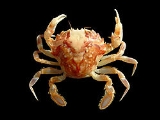
Liocarcinus marmoreus
Encyclopedia
Liocarcinus marmoreus, sometimes known as the marbled swimming crab, is a species
of crab
found in the northern Atlantic Ocean
and North Sea
. It may be found on sand
and gravel
in the sublittoral and lower littoral zones, down to a depth of 84 metres (275.6 ft), from the Azores
and the Alboran Sea
(the westernmost section of the Mediterranean Sea
) as far north as the Shetland Islands. It reaches a carapace
length of 35 millimetres (1.4 in), and is distinguished from other similar species by the presence of three similarly-sized teeth on the edge of the carapace, between the eyes, and by the marbled colouration on the carapace. L. marmoreus is sometimes parasitised
by the barnacle
Sacculina
.
Species
In biology, a species is one of the basic units of biological classification and a taxonomic rank. A species is often defined as a group of organisms capable of interbreeding and producing fertile offspring. While in many cases this definition is adequate, more precise or differing measures are...
of crab
Crab
True crabs are decapod crustaceans of the infraorder Brachyura, which typically have a very short projecting "tail" , or where the reduced abdomen is entirely hidden under the thorax...
found in the northern Atlantic Ocean
Atlantic Ocean
The Atlantic Ocean is the second-largest of the world's oceanic divisions. With a total area of about , it covers approximately 20% of the Earth's surface and about 26% of its water surface area...
and North Sea
North Sea
In the southwest, beyond the Straits of Dover, the North Sea becomes the English Channel connecting to the Atlantic Ocean. In the east, it connects to the Baltic Sea via the Skagerrak and Kattegat, narrow straits that separate Denmark from Norway and Sweden respectively...
. It may be found on sand
Sand
Sand is a naturally occurring granular material composed of finely divided rock and mineral particles.The composition of sand is highly variable, depending on the local rock sources and conditions, but the most common constituent of sand in inland continental settings and non-tropical coastal...
and gravel
Gravel
Gravel is composed of unconsolidated rock fragments that have a general particle size range and include size classes from granule- to boulder-sized fragments. Gravel can be sub-categorized into granule and cobble...
in the sublittoral and lower littoral zones, down to a depth of 84 metres (275.6 ft), from the Azores
Azores
The Archipelago of the Azores is composed of nine volcanic islands situated in the middle of the North Atlantic Ocean, and is located about west from Lisbon and about east from the east coast of North America. The islands, and their economic exclusion zone, form the Autonomous Region of the...
and the Alboran Sea
Alboran Sea
|300px|thumb|]]The Alboran Sea is the westernmost portion of the Mediterranean Sea, lying between Spain on the north and Morocco and Algeria on the south...
(the westernmost section of the Mediterranean Sea
Mediterranean Sea
The Mediterranean Sea is a sea connected to the Atlantic Ocean surrounded by the Mediterranean region and almost completely enclosed by land: on the north by Anatolia and Europe, on the south by North Africa, and on the east by the Levant...
) as far north as the Shetland Islands. It reaches a carapace
Carapace
A carapace is a dorsal section of the exoskeleton or shell in a number of animal groups, including arthropods such as crustaceans and arachnids, as well as vertebrates such as turtles and tortoises. In turtles and tortoises, the underside is called the plastron.-Crustaceans:In crustaceans, the...
length of 35 millimetres (1.4 in), and is distinguished from other similar species by the presence of three similarly-sized teeth on the edge of the carapace, between the eyes, and by the marbled colouration on the carapace. L. marmoreus is sometimes parasitised
Parasitism
Parasitism is a type of symbiotic relationship between organisms of different species where one organism, the parasite, benefits at the expense of the other, the host. Traditionally parasite referred to organisms with lifestages that needed more than one host . These are now called macroparasites...
by the barnacle
Barnacle
A barnacle is a type of arthropod belonging to infraclass Cirripedia in the subphylum Crustacea, and is hence related to crabs and lobsters. Barnacles are exclusively marine, and tend to live in shallow and tidal waters, typically in erosive settings. They are sessile suspension feeders, and have...
Sacculina
Sacculina
Sacculina is a genus of barnacles that is a parasitic castrator of crabs. The adults bear no resemblance to the barnacles that cover ships and piers; they are recognised as barnacles because their larval forms are like other members of the barnacle class Cirripedia...
.

